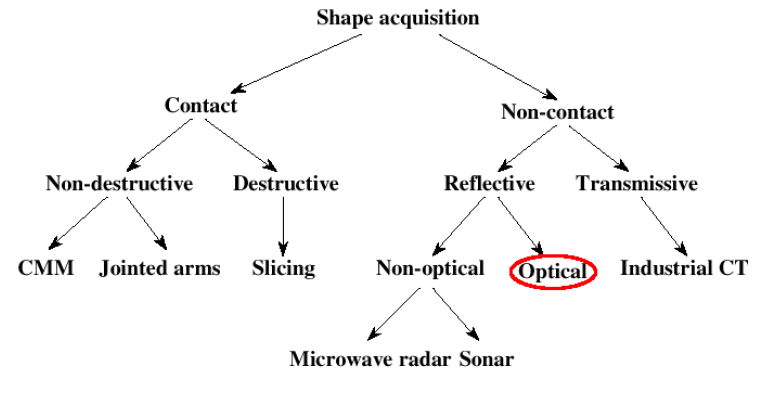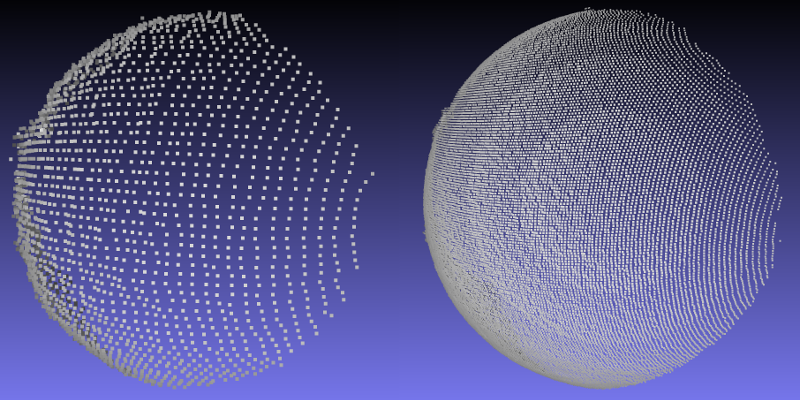|
|
| (未显示同一用户的9个中间版本) |
| 第1行: |
第1行: |
| − | == Introduction == | + | ==简介== |
| | | | |
| − | Photoneo 3D scanners work on the principle of '''[https://en.wikipedia.org/wiki/Structured_light structured light projection]''', which is an optical method of shape acquisition. For broader context, see following image: | + | Photoneo 3D扫描仪的工作原理是 '''[https://en.wikipedia.org/wiki/Structured_light 结构光投影]''',这是一种形状获取的光学方法。有关更广泛的背景,请参阅以下图像 |
| | [[File:Shape-acquisition-categorisation.png]] | | [[File:Shape-acquisition-categorisation.png]] |
| | | | |
| − | The output from the scanner is a 3D point cloud of the object's surface as viewed from one viewpoint. The scene has to be static (not moving) during the projection phase.
| + | 扫描仪的输出是物体表面从一个角度来看的3D点云。在投影阶段,场景必须是静态的(不移动)。 |
| | | | |
| − | Standard output format for point clouds is [https://en.wikipedia.org/wiki/PLY_(file_format) Stanford PLY], which can be easily imported into most 3D viewers or used by programmers.
| + | 点云的标准输出格式为 [https://en.wikipedia.org/wiki/PLY_(file_format) Stanford PLY],可以轻松导入大多数3D查看器或让程序员使用。 |
| | | | |
| − | == PhoXi Control Application == | + | == PhoXi控制应用程序 == |
| | | | |
| − | Photoneo 3D scanners are controlled via standalone application available for Windows and Ubuntu. It enables user to control 3D scanner manually through GUI or programmatically via provided API. | + | Photoneo 3D扫描仪独立应用程序进行控制,适用于Windows和Ubuntu。它使用户能够通过GUI手动控制3D扫描仪,或者通过提供的API以编程方式控制。 |
| | | | |
| − | Visit '''[http://www.photoneo.com/product-detail/phoxi-control-application/ PhoXi Control Application]''' site for download and quick start guide.
| + | 查看 '''[http://www.photoneo.com/product-detail/phoxi-control-application/ PhoXi控制应用程序]''' 网站下载和快速入门指南。 |
| | | | |
| − | == Scanning basics == | + | ==扫描基础== |
| | | | |
| − | The quality of the scan depends on multiple factors. The scanner provides a variety of settings to enable an optimal scan; however, even by rearranging the positions of the scene and scanner you can get better results. Always arrange the scene to have the best conditions for scan first and only then manipulate the settings of the scanner.
| + | 扫描的质量取决于多种因素。扫描仪有提供各种设置以获得最佳扫描;然而即使重新安排场景和扫描仪的位置,您也可以获得更好的结果。请总是先安排拥有最佳扫描条件的场景,然后才操作扫描仪的设置。 |
| | | | |
| − | === Choose the right scanner size === | + | ===选择正确的扫描仪尺寸=== |
| | | | |
| − | Answer the questions
| + | 回答以下问题 |
| − | * What is the required level of detail? | + | * 需要怎样的细节程度? |
| − | * How big is the scanning area? | + | * 扫描区域有多大? |
| | | | |
| − | ==== Level of detail ==== | + | ====细节程度==== |
| | | | |
| − | Every PhoXi 3D scanner has the resolution of 3.2 million points. Imagine this as 3 million points arranged in a grid that will cover the surface of scanned object. The density of the points decreases with the distance of the scanner from the object. For illustration, see the density of the points on the table-tennis ball scanned with model L (from the distance 1,5 m) and model S (from the distance 0.5 m).
| + | 每台PhoXi 3D扫描仪的分辨率为320万点。想象一下,将300万个点排列在将会覆盖在扫描物体表面的网格中。点的密度会随着扫描仪与物体的距离增加而减小。为了说明,请参阅使用L型(距离1.5米)和S型(距离0.5米)扫描的乒乓球上的点的密度。 |
| | | | |
| | [[File:Table-tennis-ball-scan-S-vs-L-w800.png]] | | [[File:Table-tennis-ball-scan-S-vs-L-w800.png]] |
| | | | |
| − | The level of detail and accuracy of the scanner is described in datasheet as '''point size''', '''absolute accuracy''' and '''Z noise''' ([[PhoXi 3D scanners family#Specification Parameters Explanation|See the explanation of these parameters]]).
| + | 细节的程度和扫描仪的精确度在数据表中被描述为 '''点大小''', '''绝对精度''' and '''Z 噪音''' ([[PhoXi 3D扫描仪系列#规格参数说明|请参阅这些参数的说明]])。 |
| | | | |
| − | ==== Scanning area ==== | + | ====扫描区域==== |
| | | | |
| − | '''TIP''': Use the configurator at the bottom of [http://www.photoneo.com/product-showcase/phoxi_3d_scanners/ 3D scanner site] to determine the right scanner size. | + | '''提示''':使用[http://www.photoneo.com/product-showcase/phoxi_3d_scanners/ 3D扫描仪网站]底部的配置程序来判断正确的扫描仪尺寸。 |
| | | | |
| − | For bin picking applications, the ratio of the size of the object to the box size should not exceed 1:15. For example in the europallete sized box (1200 by 800 mm) it is reasonable to scan objects with minimal size 100 mm.
| + | 对于箱柜拾取应用,物体尺寸与箱子尺寸的比例不应超过1:15。例如在europallete大小的箱子(1200×800毫米)中,合理的扫描物体最小尺寸是100毫米。 |
| | | | |
| | | | |
| − | === Distance === | + | ===距离=== |
| − | Closer objects have a better spatial resolution and generally less noise.
| + | 较近的物体具有较好的空间分辨率和通常较少的噪音。 |
| | | | |
| − | To achieve the best scan quality, put the object in the focus distance from the camera. The focus distance for each scanner is written in the corresponding datasheet, for example for the [http://www.photoneo.com/product-detail/phoxi-scan-m/ Model M] it is 683 mm.
| + | 为了获得最佳的扫描质量,请将物体放在相机的焦距处。每个扫描器的焦距写在相应的数据表中,例如[http://www.photoneo.com/product-detail/phoxi-scan-m/M型]是683毫米。 |
| | | | |
| − | To evaluate the distance of the scanned object, trigger the scan in PhoXi Control Application and then switch the view to Depth Map. The distance of the point from the camera is shown in the right panel when moving the mouse cursor over the point (pixel).
| + | 要评估扫描物体的距离,请在PhoXi控制应用程序中触发扫描,然后将视图切换至深度图。将鼠标光标移动到点(像素)上时,该点与相机的距离会显示在右侧面板中。 |
| | | | |
| − | === Light conditions === | + | ===光照条件=== |
| | | | |
| − | Indoor [[ambient light]] generally does not influence the scan. However, very strong light such as direct sun might be a problem. This occurs especially when scanning outdoors. Try to remove all sun illumination e.g. by shadowing the window, or by moving into a different place.
| + | 室内[[环境光]]通常不会影响扫描。然而,太阳直射之类的强光可能会成为问题。在户外扫描时特别会发生这种情况。尝试去除所有阳光照射,例如通过遮蔽窗户或移动到另一个地方。 |
| | | | |
| − | === Material properties === | + | ===材料属性=== |
| | | | |
| − | ==== 反射率 (反照率) ==== | + | ====反射率(反照率)==== |
| − | A material with higher [[Albedo|albedo]] provides a better signal-to-noise ratio, resulting in higher scan quality. Very dark materials requires longer exposure and might have higher level of noise.
| + | 具有较高[[Albedo|反射率]]的材料可提供更好的信噪比,从而提高扫描质量。非常黑暗的材料需要更长时间的曝光,并且可能会有更多的噪音。 |
| | | | |
| − | ==== 反射 ==== | + | ====反射==== |
| − | Generally, non-glossy, matte materials are scanned without problem. Even soft-gloss objects have a nearly optimal scan. However, any specular reflections might influence the scan quality since the projected light is reflected out of the sight of the camera (in which case that part has a poor quality), or when reflected into other parts of the scene, reflected light interferes with scanning (in which case the part illuminated by reflection has artifacts). Especially metal with high-gloss finish (mirror-like) is problematic.
| + | 通常,无光泽、磨砂的材料扫描没有问题。即使是光泽柔和的物体也有近乎最佳的扫描。然而,任何镜面反射都可能影响扫描质量,因为投影光线被反射到相机视线之外(在这种情况下,该部分有较差的质量),或者当反射到场景的其他部分时,反射光会干扰扫描(在这种情况下,由反射照亮的部分具有伪影)。特别是高光泽的金属(镜面状)是有问题的。 |
| | | | |
| − | ''As a rule of thumb: Take a flat piece of the material and try to look at it as it be a mirror. If you are able to recognize a shape of your head as reflected by the material, the material is glossy. Depending on the scene, some parts might be not scanned optimally.'' | + | ''作为一个经验法则:取材料的平整部份,试着将它看成是一面镜子。如果您能够识别材料反射的您的头部形状,则材质很光滑。根据现场情况,某些部件可能无法获得最佳扫描。'' |
| | | | |
| − | When scanning glossy objects, find a position where light coming from the projection unit does not illuminate other objects on the scene.
| + | 在扫描有光泽的物体时,找出投影元件发出的光线不会照亮场景中其他物体的位置。 |
| − | To further increase change of optimal scan while scanning glossy materials, use the “Scan glossy / Scan on sunlight” setting. Using this setting will increase the scanning time.
| + | 要在扫描光面材料时做更多优化扫描的变动,请使用“扫描光面/在阳光下扫描”设置。使用此设置将增加扫描时间。 |
| | | | |
| − | ==== 透明物体 ==== | + | ====透明物体==== |
| − | It is not possible to scan transparent materials such as glass, ice or water . Remove such materials from the scene to avoid artifacts. A thin layer of plastic wrap would still allow the wrapped object to be scanned with the risk of greater noise. It might also increase the glossiness of the object (see previous paragraph). Scanning through a window is possible as long as the window does not cause reflection — the angle between projector unit and window should be close to a right angle.
| + | 无法扫描透明材料,如玻璃、冰块或水。从场景中移除这些材料以避免伪影。有一层薄薄的塑料包膜仍然可以扫描被包裹的物体,同时带有更大噪音的风险。它也可能会增加物体的光泽度(请参阅上一段)。只要窗户不会引起反射,窗户就可以扫描 - 投影仪元件和窗户之间的角度应该接近直角。 |
| | | | |
| − | ==== 半透明物体 ==== | + | ====半透明物体==== |
| − | It is possible to scan translucent objects to some extent. Scattering of the light inside the material might cause the object surface to be scanned with a lower precision. For materials of a high degree of translucency the same applies as for the transparent objects.
| + | 可以在一定程度上扫描半透明物体。材料内部光线的散射可能会导致物体表面扫描精度降以低。对于高度半透明的材料,则同样适用于透明物体。 |
简介
Photoneo 3D扫描仪的工作原理是 结构光投影,这是一种形状获取的光学方法。有关更广泛的背景,请参阅以下图像

扫描仪的输出是物体表面从一个角度来看的3D点云。在投影阶段,场景必须是静态的(不移动)。
点云的标准输出格式为 Stanford PLY,可以轻松导入大多数3D查看器或让程序员使用。
PhoXi控制应用程序
Photoneo 3D扫描仪独立应用程序进行控制,适用于Windows和Ubuntu。它使用户能够通过GUI手动控制3D扫描仪,或者通过提供的API以编程方式控制。
查看 PhoXi控制应用程序 网站下载和快速入门指南。
扫描基础
扫描的质量取决于多种因素。扫描仪有提供各种设置以获得最佳扫描;然而即使重新安排场景和扫描仪的位置,您也可以获得更好的结果。请总是先安排拥有最佳扫描条件的场景,然后才操作扫描仪的设置。
选择正确的扫描仪尺寸
回答以下问题
细节程度
每台PhoXi 3D扫描仪的分辨率为320万点。想象一下,将300万个点排列在将会覆盖在扫描物体表面的网格中。点的密度会随着扫描仪与物体的距离增加而减小。为了说明,请参阅使用L型(距离1.5米)和S型(距离0.5米)扫描的乒乓球上的点的密度。

细节的程度和扫描仪的精确度在数据表中被描述为 点大小, 绝对精度 and Z 噪音 (请参阅这些参数的说明)。
扫描区域
提示:使用3D扫描仪网站底部的配置程序来判断正确的扫描仪尺寸。
对于箱柜拾取应用,物体尺寸与箱子尺寸的比例不应超过1:15。例如在europallete大小的箱子(1200×800毫米)中,合理的扫描物体最小尺寸是100毫米。
距离
较近的物体具有较好的空间分辨率和通常较少的噪音。
为了获得最佳的扫描质量,请将物体放在相机的焦距处。每个扫描器的焦距写在相应的数据表中,例如[1]是683毫米。
要评估扫描物体的距离,请在PhoXi控制应用程序中触发扫描,然后将视图切换至深度图。将鼠标光标移动到点(像素)上时,该点与相机的距离会显示在右侧面板中。
光照条件
室内环境光通常不会影响扫描。然而,太阳直射之类的强光可能会成为问题。在户外扫描时特别会发生这种情况。尝试去除所有阳光照射,例如通过遮蔽窗户或移动到另一个地方。
材料属性
反射率(反照率)
具有较高反射率的材料可提供更好的信噪比,从而提高扫描质量。非常黑暗的材料需要更长时间的曝光,并且可能会有更多的噪音。
反射
通常,无光泽、磨砂的材料扫描没有问题。即使是光泽柔和的物体也有近乎最佳的扫描。然而,任何镜面反射都可能影响扫描质量,因为投影光线被反射到相机视线之外(在这种情况下,该部分有较差的质量),或者当反射到场景的其他部分时,反射光会干扰扫描(在这种情况下,由反射照亮的部分具有伪影)。特别是高光泽的金属(镜面状)是有问题的。
作为一个经验法则:取材料的平整部份,试着将它看成是一面镜子。如果您能够识别材料反射的您的头部形状,则材质很光滑。根据现场情况,某些部件可能无法获得最佳扫描。
在扫描有光泽的物体时,找出投影元件发出的光线不会照亮场景中其他物体的位置。
要在扫描光面材料时做更多优化扫描的变动,请使用“扫描光面/在阳光下扫描”设置。使用此设置将增加扫描时间。
透明物体
无法扫描透明材料,如玻璃、冰块或水。从场景中移除这些材料以避免伪影。有一层薄薄的塑料包膜仍然可以扫描被包裹的物体,同时带有更大噪音的风险。它也可能会增加物体的光泽度(请参阅上一段)。只要窗户不会引起反射,窗户就可以扫描 - 投影仪元件和窗户之间的角度应该接近直角。
半透明物体
可以在一定程度上扫描半透明物体。材料内部光线的散射可能会导致物体表面扫描精度降以低。对于高度半透明的材料,则同样适用于透明物体。

